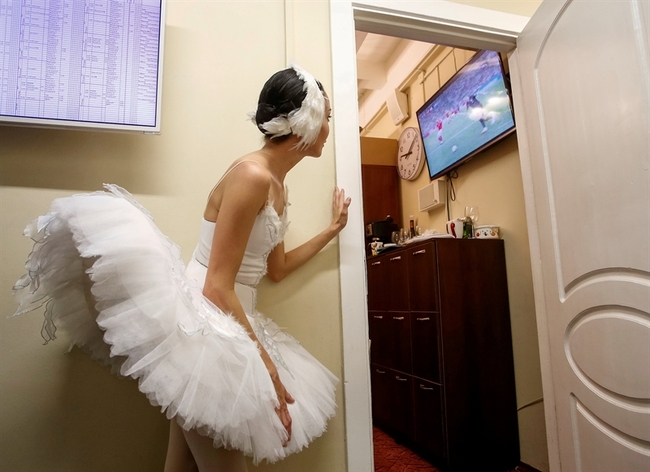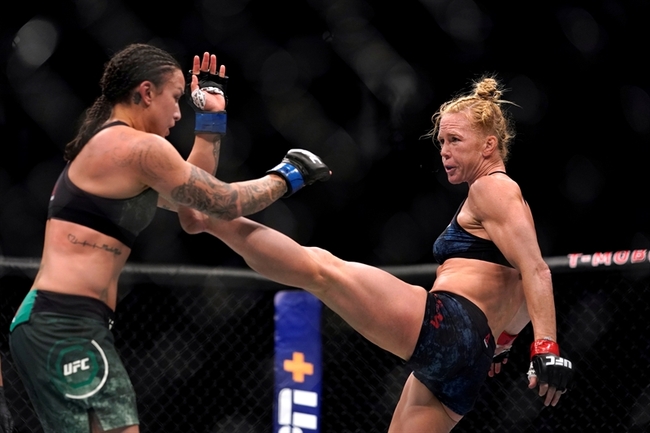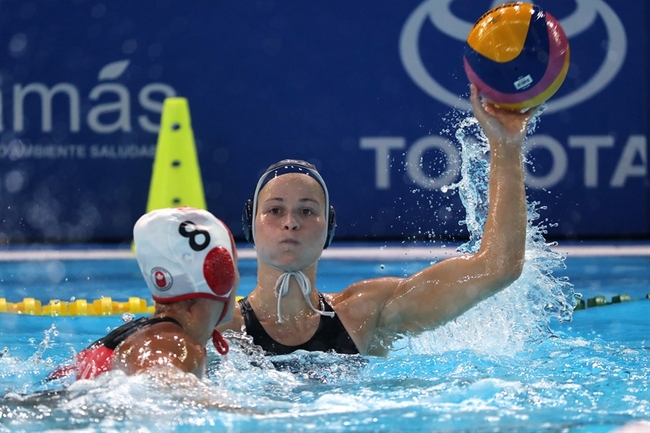Masterclass: LARS - Part I. A new way forward for ACL reconstruction?
In part I of this two-part Masterclass article, Chris Mallac discusses in detail the postoperative rehab requirements following a unique ACL reconstruction method – a Ligament Advanced Reinforcement System (LARS) procedure.
Anterior cruciate ligament (ACL) rupture is a common injury suffered by many athletes in a variety of sports. It typically affects athletes involved in sports that require sharp deceleration and cutting/pivoting type movements such as all the football sports (soccer, rugby, AFL, NFL), basketball, netball, golf and tennis. It may also occur as the result of a direct blow to the outside of the knee, which causes a valgus knee collapse, imposing large tensile and torsional forces to both the medial collateral ligament (MCL) and ACL.
It has been estimated that 80% of all ligament reconstructions of the knee relate to the ACL1. It is accepted that ACL ruptures have poor intrinsic healing capabilities due to the fact that the ACL is enveloped by synovial fluid and lacks significant vascularisation2. This makes healing of this intra-articular ligament impossible due to the inability of the torn ligament to re-vascularize.
In many case therefore, this precipitates the need to reconstruct the ACL to achieve functional stability to withstand anteroposterior shear forces and to prevent rotational forces on the knee. This course of action will prevent any further meniscus breakdown, and early onset osteoarthritis due to the excessive shearing forces encountered by the ACL deficient knee3,4.
| Surgical options following ACL rupture |
|---|
| The decision to reconstruct the ACL is multifactorial and both the attending surgeon and patient discuss the need to reconstruct along the following paradigm(3): 1.Degree of symptoms — such as uncontrollable instability or giving way of the knee. 2. Age — younger athletes will have longer exposure to potentially joint damaging instability episodes. Therefore, early reconstruction to develop functional stability may be preferred even though there exists a lengthy rehabilitation process. An older athlete nearing retirement may prefer to take their chances rather than stepping out of training/competition for 9-12 months. 3. Participation in a pivoting sport such as football (all codes), netball, basketball, tennis, dance to name a few. 4. Level of activity — elite athletes are well advised to always have an ACL reconstructed whereas a recreational athlete may have different needs.5. Failure or success of conservative management focusing on proprioception and hamstring strengthening |
Surgical techniques vary from surgeon to surgeon and from country to country. Indeed, it is not uncommon for two orthopaedic surgeons from the same sports medicine clinic to differ in their surgical choices. The options the surgeon has include:
- Arthroscopic versus open surgery.
- Intra versus extra-articular reconstruction.
- Femoral tunnel placement.
- Number of graft strands.
- Single versus double bundle.
- Fixation methods.
The use of grafts falls into three different subtypes:
- Autologous grafts such as the patellabone- patella (PTB) graft and the quadruple gracilis/hamstring graft techniques. These are the most commonly used as the graft is taken from the patient thus eliminating the risk of graft rejection5. The major drawback of these grafts is possible donor site problems and the length of time it takes for the graft to re-vascularise (6-9 months)6.
- Allografts are harvested from a human tissue bank and the common allograft tendons to use are tibialis posterior, Achilles tendon or peroneus tendon and hamstring. The benefit is that there is no donor site morbidity at the knee. However the risk of graft rejection is quite high, the recovery rate is longer, post-operative infections more common and there are higher failure rates5,6.
- Synthetic grafts using Polyethylene Terephthalate, Polypropylene, Polytetrafluroethene (PTFE), Carbon Fibre or Dacron. The original grafts used in the 1980s had high rates of failure and reactive synovitis so they fell out of favour7.
However synthetic grafts are now in their third generation and in the last 20 years the Ligament Advanced Reinforcement System (LARS) procedure has gained more popularity with orthopaedists8.
What is a LARS procedure?
The LARS system was developed in France by a French surgeon called Professor JP Laboreau. This was developed over a lengthy period of time, finding a material and technique that would prevent the failure rates seen with other synthetic grafts, and to also avoid the morbidity seen with human tissue grafts involving the patella tendon and hamstring grafts.
LARS has been used successfully to reconstruct ACL ruptures in countries such as Australia, United Kingdom, France, Germany and Canada. However, the United States has still not approved the use of LARS in the USA, with the result that American athletes often seek surgical treatment in other countries.
A LARS is an intra-articular scaffold consisting of an interosseous component of multiple parallel fibres of Polyethylene Terephthalate (PET) polyester (see figure 1). The intra-articular segment is unique and different to other synthetic grafts in that it is twisted at 90 degree angles.
Figure 1: LARS scaffold consisting of an interosseous component of multiple parallel fibres of PET polyester
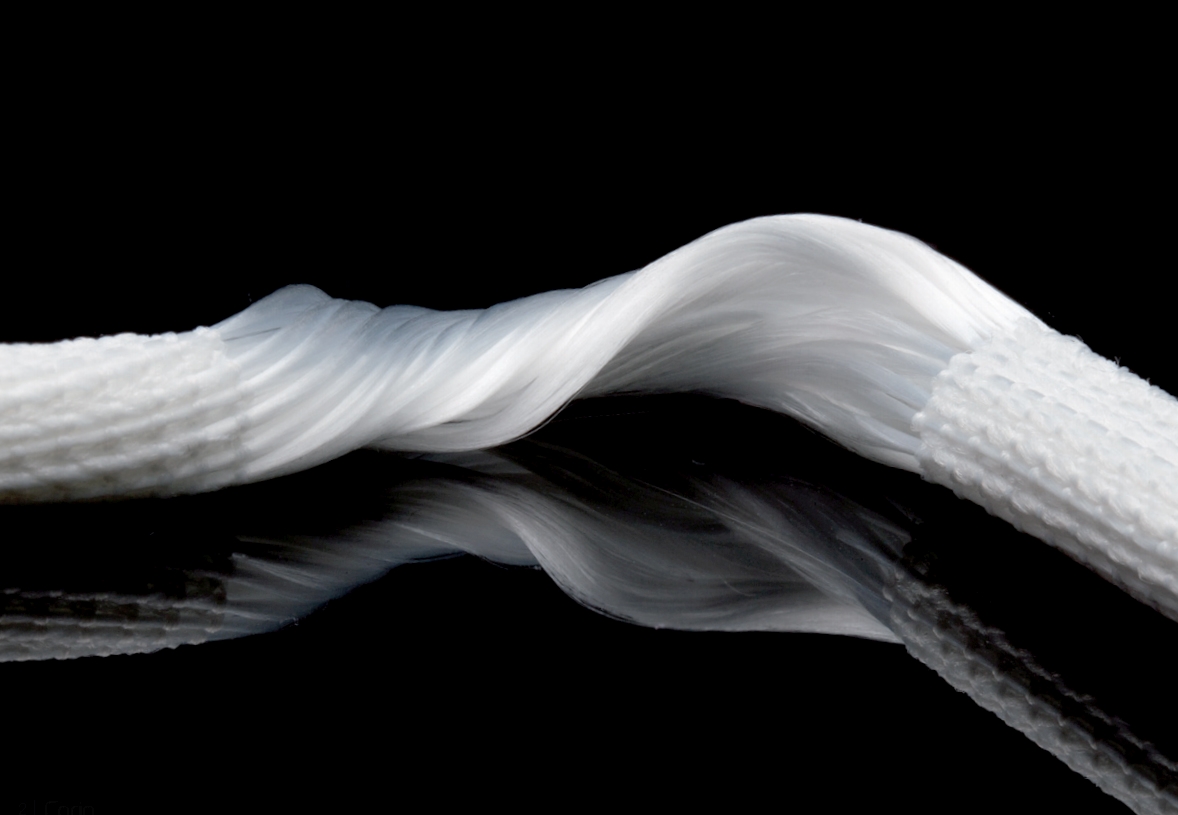
Biomechanically, this artificial ligament mimics the natural ligamentous structure of the ACL and this design reduces shearing forces by specifically orientating the intra-articular fibres either clockwise for right knees or counterclockwise for left knees. The porous nature of the PET fibres allow ingrowth from surrounding osseous tunnels and the remaining ACL stump. The ingrowth of the tissues into this scaffold gives the graft greater viscoelasticity and also protects against friction at the opening of the bony canal and between the fibres themselves2.
The LARS artificial ligament is sterilised and chemically treated to remove any potential machining residues. Also, the emulsion of fat enzymes that may prevent soft tissue ingrowth and the sterility reduces the risk of reactive synovitis and fibre breakdown associated with other synthetic grafts9, 10.
In a LARS procedure, the synovial lining and the torn ACL fibres are left intact, whereas in other ACL reconstructive procedures the ACL is debrided to allow osseous tunnel drilling for the autologous graft. The osseous tunnels are positioned under image intensifier x-ray and this allows the torn ACL stump to remain. The proposed advantage of this technique is reduced trauma to the soft tissues of the knee and less surgical time8. The remaining ACL stump is anchored to the meshwork of the LARS to support it in an optimum position while healing. Figure 2 shows a summary of a typical LARS operative procedure.
Figure 2: Summary of LARS operative procedure*
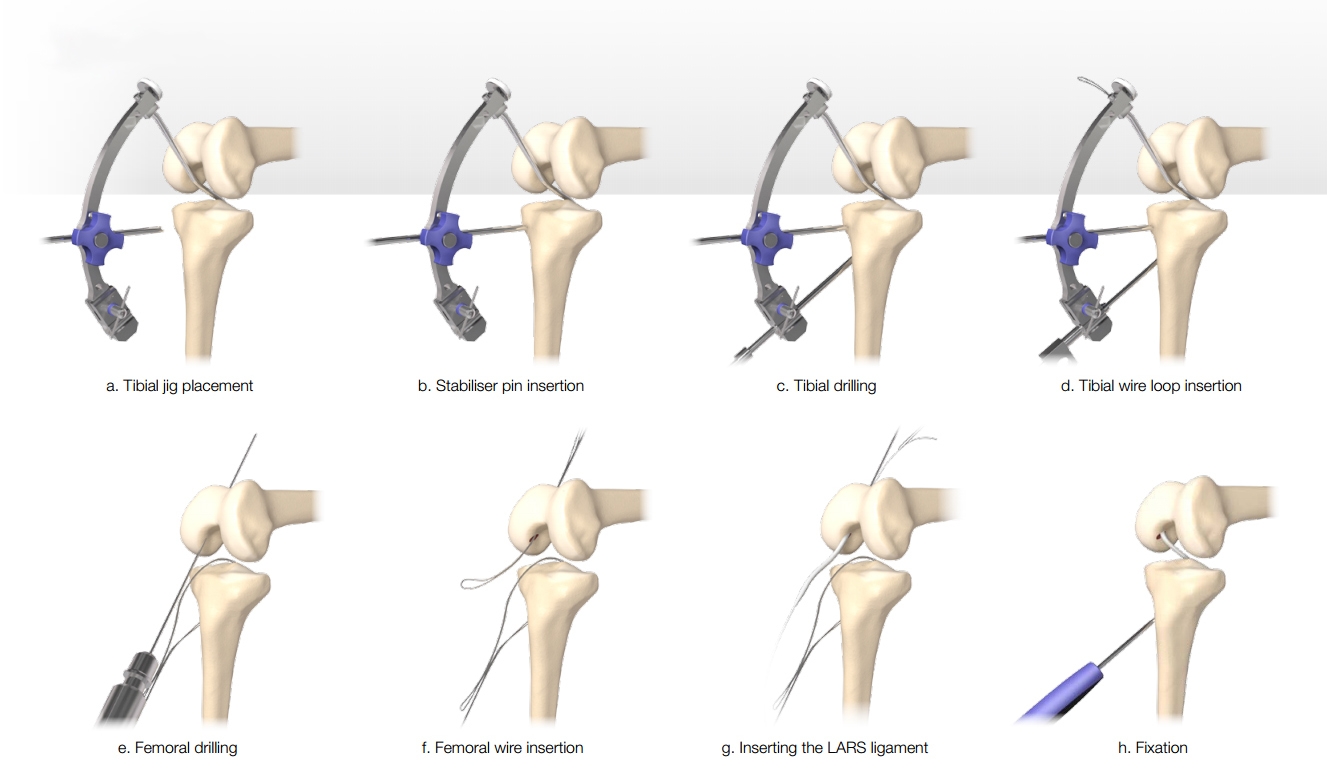
Overall, the LARS surgical technique aims to maximise in-growth of the original ACL tissue, thus preserving some vascular and proprioceptive nerve supply. The biggest advantages of this procedure are immediate graft stability, reduced rehabilitation time and quicker return to pre-injury function. Over time, the existing ACL stump regrows into the matrix and eventually replaces the LARS. Therefore it is not used a stand- alone graft. It has been proposed that the benefit of the LARS procedure is that it allows early post-operative loading because the scaffold protects the ACL stump during its revascularisation phase, with less chance of post-operative breakdown6.
| Does LARS work? |
|---|
| Not many studies have effectively looked at the success rate of a LARS procedure in isolation, or LARS versus conventional ACL reconstructions. The following points summarise some of these findings: 1. In a large systematic review, it was found that in the data from 675 LARS ACL reconstructions, an overall failure rate of only 2.5% was found. Most of these were associated with iatrogenic failures such as placement of the osseous tunnels. Post-operative synovitis only occurred in one case, suggesting that these new LARS grafts solved the problem of postreconstructive synovitis with other synthetic grafts(12). 2. Another study with 220 patients reported a small number of infections (1.4%) and 9 ligament re-ruptures (4%). But 83% of patients reported returning to full sport by 6 months, with 41% returning by 4 months, which is significantly faster than traditional autologous grafts(8). 3. In a study that compared the standard hamstring graft versus the LARS procedure, it was found that the autologous hamstring graft group was protected over the first three months whereas in the LARS graft protection was not needed.Therefore, non-competitive sports activity was allowed within two months and return to full activity was allowed between three to four months. All patients returned to sport by six months with no failure rates. No differences in terms of functional outcomes were reported(12). 4. A retrospective study of LARS versus the 4-strand hamstring graft with a minimum follow up of 48 months demonstrated that the LARS group displayed significantly greater knee stability measures (IKDC scores, Lysholm scores and Tegner scores) compared to the hamstring graft group(14).5. Two other studies found that LARS procedures resulted in faster return to sport with no failure rates over a 2-year(15) and 4-year period(16). |
The biggest potential problem faced when using a LARS procedure is the quality of the remaining ACL stump8. A viable stump is needed to allow new ligamentous tissue, and surgery needs to occur as soon as possible after injury to preserve the native ACL stump11. Therefore, the LARS reconstruction may be best suited to patients with acute ruptures who possess a viable cruciate stump. This allows the ligamentous and neurovascular tissues to regenerate along the synthetic scaffold. Furthermore, placement and tensioning of the LARS is crucial to prevent failure, emphasising the need for an experienced surgeon to perform this procedure. Finally, it may not be appropriate in ACL ruptured knees that have co-existing pathologies such as large meniscal tears or osteochondral defects; these patients are generally delayed in return to sport, making the benefit of the fast return with LARS pointless.
Summary
Part I of this 2-part Rehabilitation Masterclass has focused on the innovative (and at times controversial) LARS procedure as a means of reconstructing the ruptured ACL. It is still a relatively new procedure that lacks long-term follow-up studies assessing success and failure rates compared to traditional ACL reconstruction. Due to the unique synthetic properties of the LARS, it is proposed that athletes will return to competition much faster than with traditional ACL reconstruction. Therefore, the post-operative rehabilitation will differ significantly in both time and content compared with the traditional ACL reconstruction. Part II of this article therefore discusses in depth the postoperative process following a LARS reconstruction.
References
1 - J Sci Med Sport 2009, 12:622-627
2 - World J Orthop. 2015 Jan 18; 6(1): 127–136
3. Br J Hosp Med (Lond) 2008; 69: 459-60, 462- 463
4. Am J Sports Med 2006, 34(12):2026-37
5. J Arthroscopic & Related Surg 2009, 25(9):1006-1010
6. J Arthroscopic & Related Surg 2009, 25(6):653-85
7. Eur Surg Res 2004, 36:148-151
8. Operative Techniques in Sports Medicine 1995, 3(3):187-20
9. Eur Surg Res 2004, 36:148-151 British Medical Bulletin 2010
10. 1-24 Chin Med J 2010, 123(2):160-164
11. Knee surgery, Sports Traumatology, Arthroscopy 2010. 18, 797-804
Newsletter Sign Up
Subscriber Testimonials
Dr. Alexandra Fandetti-Robin, Back & Body Chiropractic
Elspeth Cowell MSCh DpodM SRCh HCPC reg
William Hunter, Nuffield Health
Newsletter Sign Up
Coaches Testimonials
Dr. Alexandra Fandetti-Robin, Back & Body Chiropractic
Elspeth Cowell MSCh DpodM SRCh HCPC reg
William Hunter, Nuffield Health
Be at the leading edge of sports injury management
Our international team of qualified experts (see above) spend hours poring over scores of technical journals and medical papers that even the most interested professionals don't have time to read.
For 17 years, we've helped hard-working physiotherapists and sports professionals like you, overwhelmed by the vast amount of new research, bring science to their treatment. Sports Injury Bulletin is the ideal resource for practitioners too busy to cull through all the monthly journals to find meaningful and applicable studies.
*includes 3 coaching manuals
Get Inspired
All the latest techniques and approaches
Sports Injury Bulletin brings together a worldwide panel of experts – including physiotherapists, doctors, researchers and sports scientists. Together we deliver everything you need to help your clients avoid – or recover as quickly as possible from – injuries.
We strip away the scientific jargon and deliver you easy-to-follow training exercises, nutrition tips, psychological strategies and recovery programmes and exercises in plain English.







